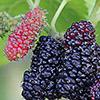Morus nigra (Black mulberry) is a dioecious tree that reaches a height of 9-10 meters. It grows in ornamental gardens and is dispersed to open spaces and to the sides of orchards by birds. The tree is winter-deciduous with a broad crown, lignified trunk and branches. It is known for its juicy fruits, and the leaves serve as food for silkworms. It originates from the region of Persia from which it was passed to broad areas of Asia, Europe and North America.
The leaves are simple and large. They are 5-7 cm long, usually split into three lobes. Three to five veins that begin at the base divide into the lobes. The leaf margin is dentate, and the lower side of the leaf is usually pilose. There is a difference in the color and scabrousness of the young leaves which are light green in color, and the mature leaves, which are dark in color, and are more rigid and scabrous. The leaves are alternate on the branches.
Sprouting and bloom occur in the spring. The male inflorescence is a catkin that is shed within a short time. The female inflorescence is actually a catkin-like spike. Numerous female flowers sit densely on one axis. Each flower contains four tepals, four stamens and an inferior ovary. The style ends in two stigmata. After pollination which occurs by wind, and fertilization, the tepals fuse and fill with a juicy sap. Each flower actually forms a small fruit, called a nutlet, which contains a hard seed. All the nutlets sit on one axis, and create a pseudocarp which is known as the mulberry fruit. The color of the fruit changes from green to red or black. It is edible and tasty. As mentioned, the seeds of the mulberry are dispersed by birds that feed on the fruit.
There are approximately 12 species of mulberry, one species fruits are white and their taste is also sweet. The tree was known in China already before 4000 BCE. It became dispersed around the world as the silk-production industry developed. China, Japan, India and other countries in Asia are today the center for silk production. In these countries mulberry trees are grown in order to feed the millions of silkworms, from whose pupae silk threads are produced. In Israel attempts to grow silkworms were also made in the early settlements, and mulberry orchards were planted for this purpose.
Written by Dr. Erga Aloni







